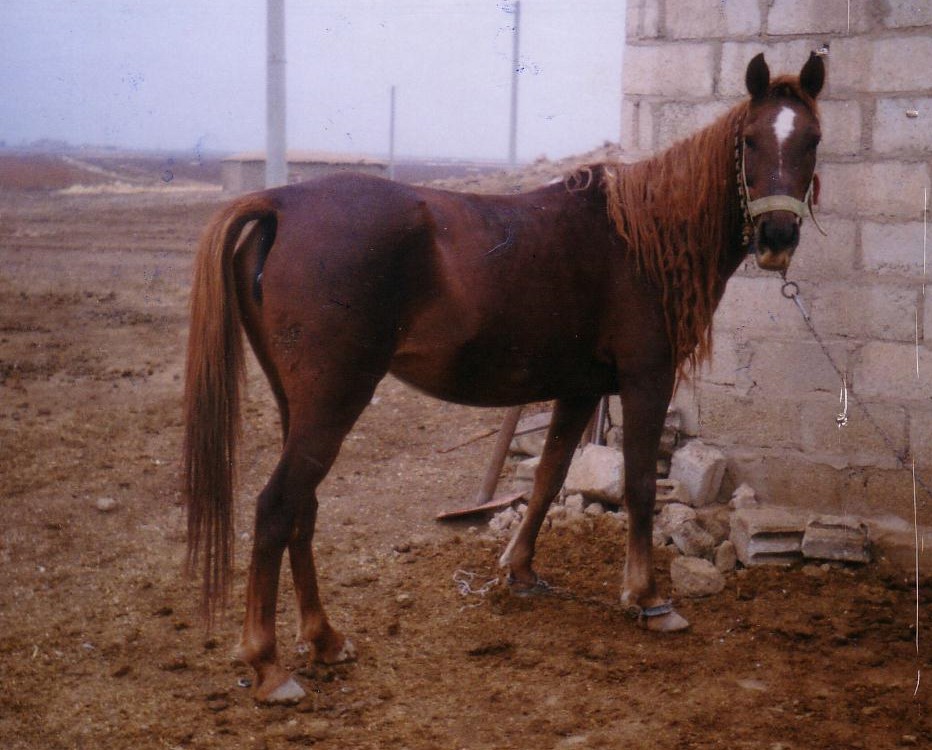The Shuwayman Sabbah strain between the Tai and Shammar Shaykhs: a family affair
Lineages of desert-bred horses are surprisingly resilient. Each time I think a line is lost it seems to reappear somewhere else. I have been following the Shuwayman line of the Jarbah Shaykhs for three decades now. Many mares were lost during the Syrian civil war, and I feared the strain was lost. Yet a branch has survived with a branch of the Shaykhs of Tai in the Upper Jazirah. It is now helping regenerate that strain. It traces to that liver chestnut mare, born in 1986.

Sire: a grey Saqlawi Jadran of the strain of Ibn ‘Amud, from the marbat of ‘Abd al-Hamid al-Talal al-Abd al-Rahman of the Shaykhs of Tai. His sire a Saqlawi Jadran Ibn ‘Amud of the same marbat.
Sire of dam: a grey Saqlawi Jadran Ibn ‘Amud of Farhan al-Nayif al-Abd al-Rahman of the Shakyhs of Tai. His sire a Saqlawi Jadran Ibn Amud of ‘Abd al-Hamid al-Talal. His dam a grey Saqlawiyah Jadraniyah Ibn ‘Amud of Abd al-Hamid al-Talal.
Sire of grand-dam: the black Marzaqani stallion of Al-‘Anud, the wife of Faris al-Abd al-Rahman of the Shaykhs of Tai. She had received him from the Maraziq as a colt. His sire I think the famous black Marzaqani of the Maraziq, but I am not sure.
Sire of great-grand dam: a Krushan of Nuri al-Mashal Pasha al-Jarba. Great grand-dam a bay mare of Nuri al-Mashal of the Shammar Jarba, given by Nuri’s wife (a Tai princess, sister of Faris al-Abd al-Rahman) to her sister’s son, the son of Abd al-Hamid al-Talal al-Rahman.
Very much a family affair between shaykhs since the 1950s.
Way back in the 1870s you would find the bay Shuwaymah Sabbah which Faris al-Jarba was riding when Lady Anne Blunt visited him.
I remember well the article you did (based on a talk for an Al Khamsa Convention) tracing the line from Faris al-Jarba’s bay Shuwaymah Sabbah to current times, with photos. Fascinating stuff!
What a beautiful mare! And hooray for the resilience of these lines, finding a way to hang on.
I feel like this is a good tie-in with your recent article about your father and his acquisition of the unregistered mare. These horses will likely survive with or without registration because of who they are and what they mean to the people that take care of them. I don’t think I could say the same for a line in a country like the US, where a horse might as well be a mongrel nobody if it does not have its papers. Hard to breed forward a “mongrel nobody” when you live in a country that places a premium on registered livestock. A point in favor of strains, I think.
I am happy to hear of another desert line that is still existant. I agree with Moira’s statement above. Personally, I would give greater credence to the authenticity of a horse from family/tribal tradition, than the average western registered horse, though it may not have been evident by my remark on the blog post, “She will be registered in my head.” I have seen too many western horses, of Asil pedigree, basically disappear for want of registration paperwork. A tragic loss of genetics, so I champion follow through in registering western born horses.
What is even more impressive is the existence of many more lines in Syria, many of which still not registered, whose owners are still equally attach to breeding them pure. It’s as if they do not value a horse more if it is registered.
I have a Shuwayman Sabbah mare with double Folla.